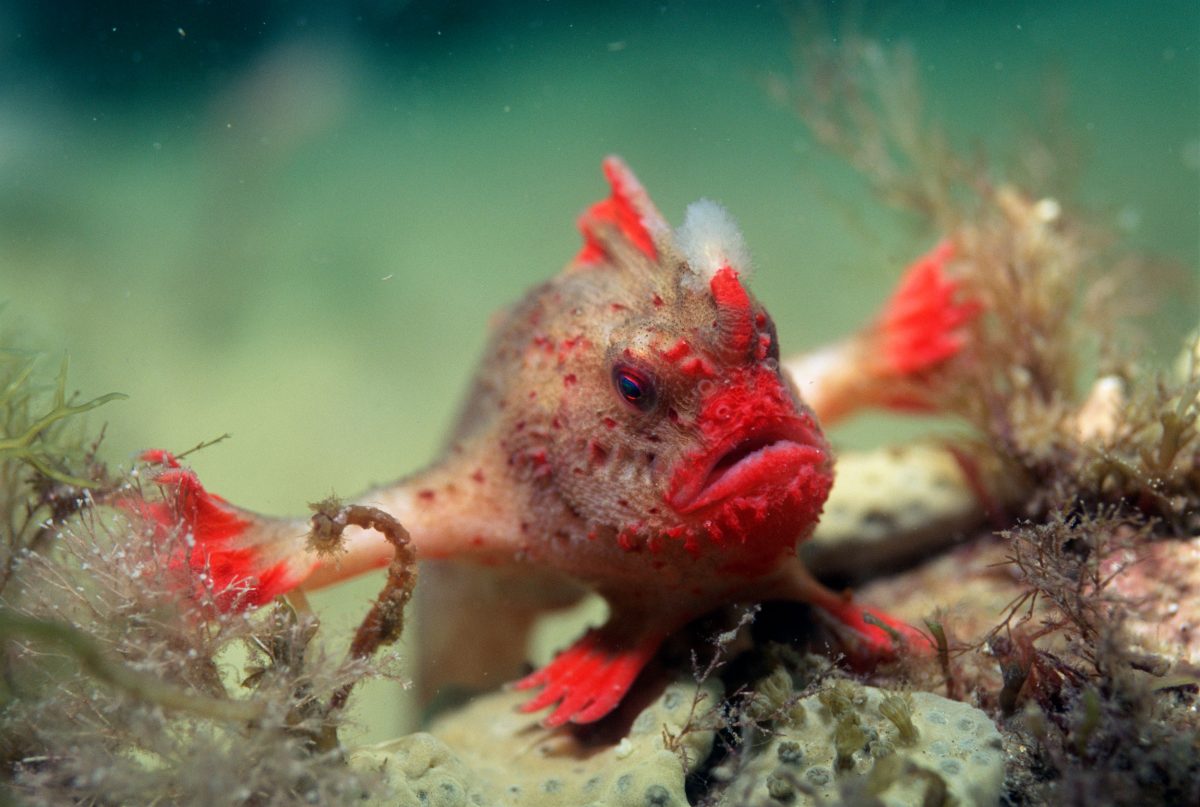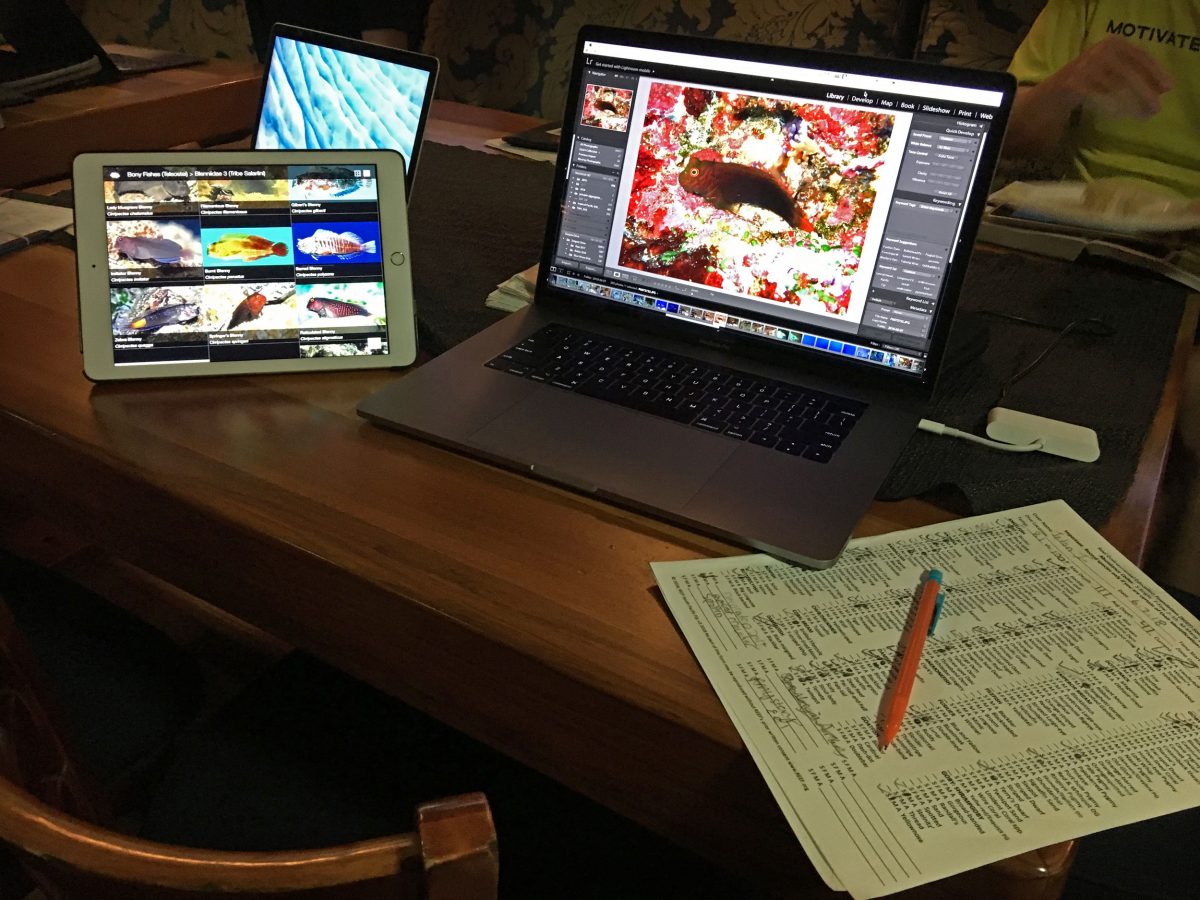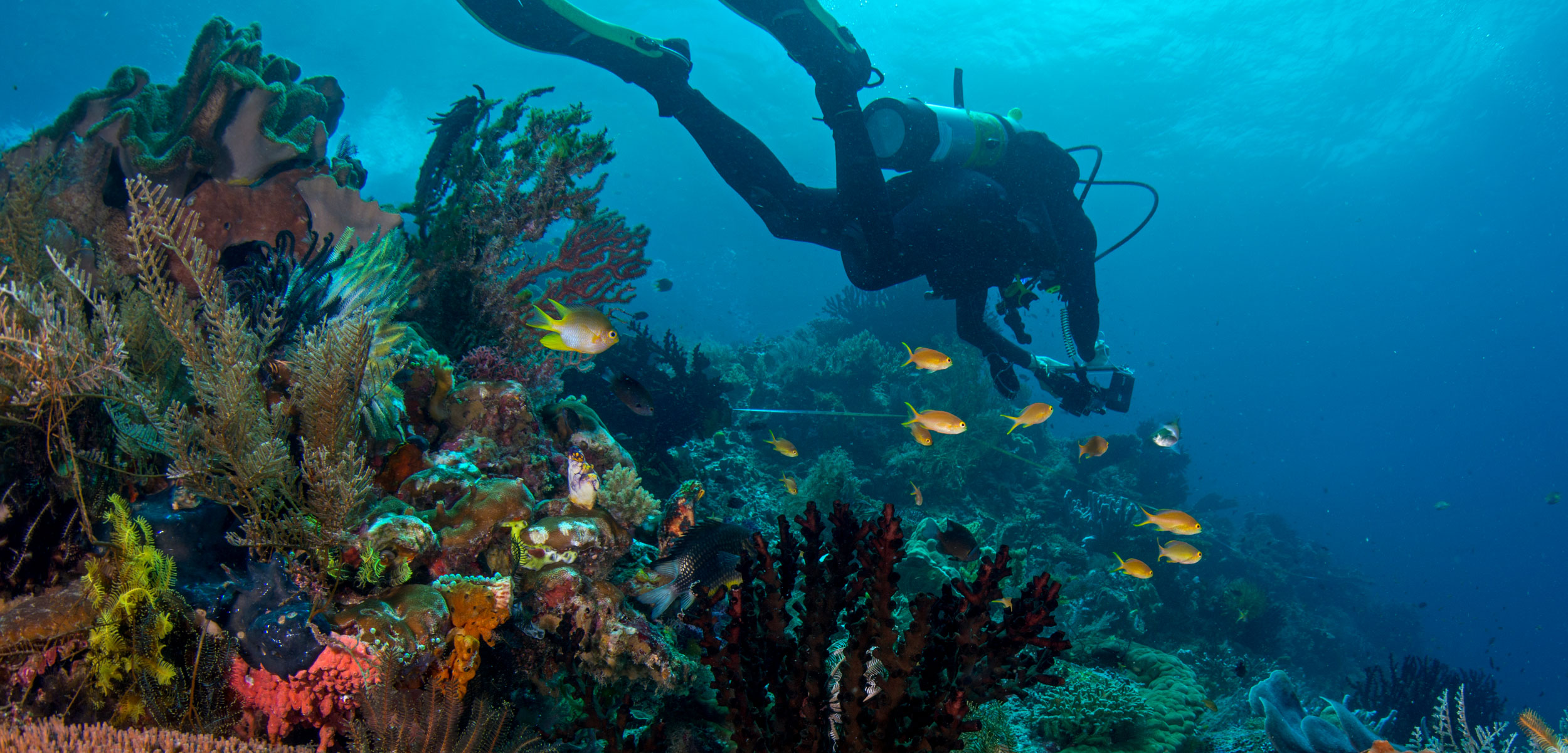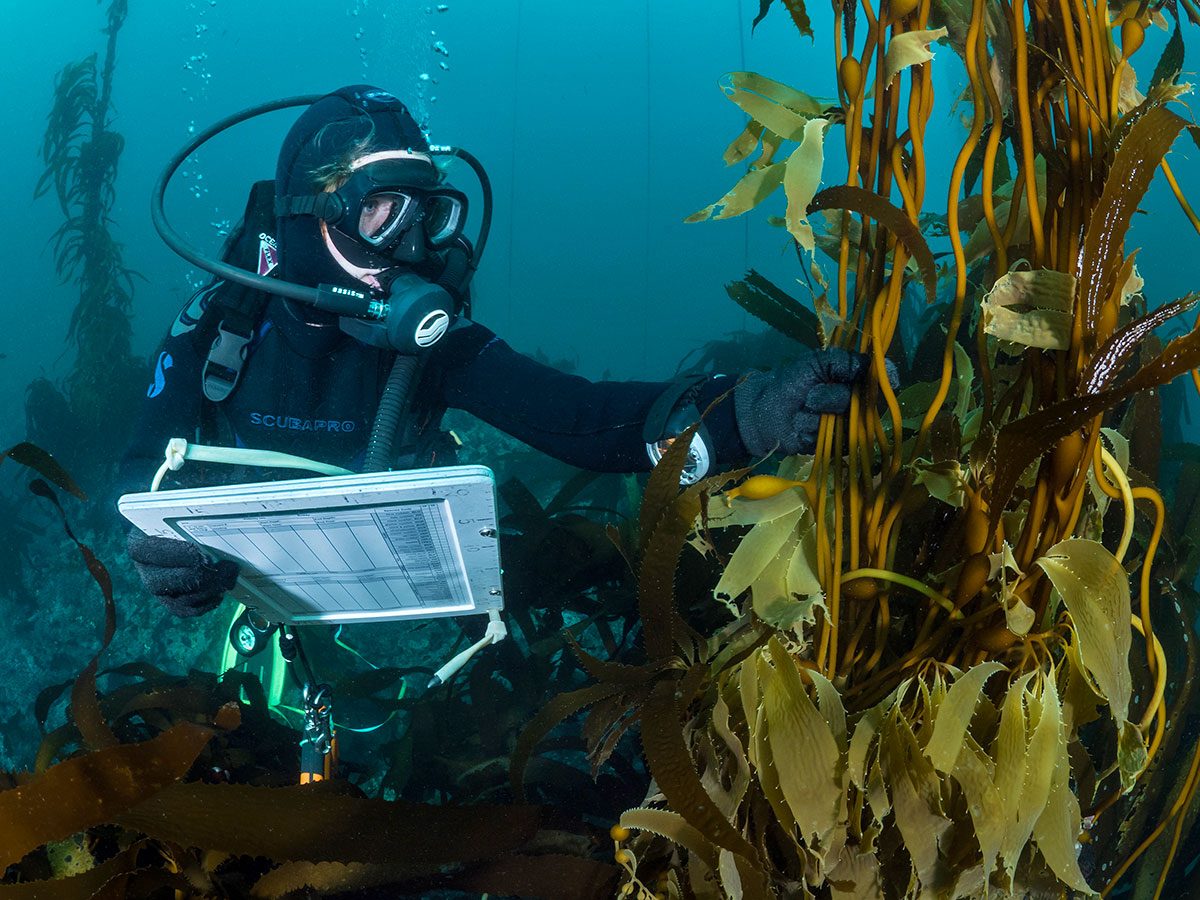Citizen Science Comes of Age
Increasingly, scientists are relying on data gathered by volunteers to make their research happen.
Article body copy
A team of seven scuba divers crawled along the seafloor in a shallow bay off Tasmania, Australia, parting tufts of seaweed and peering under small rock ledges as they hunted for a rosy-hued fish scarcely bigger than a mouse with a pouty face, hand-like pectoral fins, and a posture reminiscent of a frog’s.
The divers, five of whom were trained volunteers with an Australia-based citizen science group called Reef Life Survey, had already spent many hours underwater searching after receiving a tip from the public about a sighting of the critically imperiled species. Now, after more than two hours without luck, it appeared they were on another fruitless excursion. They were ready to call it quits when Antonia Cooper, of the Institute for Marine and Antarctic Studies, came mask to snout with her team’s quarry: a red handfish, one of just several dozen individuals believed to survive. The group doubled down on their hunting and quickly found seven more of the animals.
The discovery in 2018 prompted the creation of the Handfish Conservation Project, a national effort to protect red handfish and their two isolated patches of Tasmanian habitat, as well as their endangered relatives—the spotted handfish and the Ziebell’s handfish. The event was also noteworthy for another reason: it might not have been possible without the volunteer labor of citizen scientists. Rick Stuart-Smith, a cofounder of Reef Life Survey and one of the divers who discovered the new red handfish population, says the collective effort that it took to find the rare fish outweighed what he and his university colleagues might have been able to accomplish in the absence of volunteers. He says teams of trained volunteer divers scoured about 30 underwater locations in Tasmania, specifically searching for red handfish, before succeeding. Their work allowed Stuart-Smith and his team to know for sure that the species was in real trouble. “Citizen science was critical for the conservation of this species,” he says.

After about 30 dives and dozens of hours of volunteer time, citizen science divers from the organization Reef Life Survey finally located eight red handfish, a critically endangered species, in the waters off Tasmania, Australia. This discovery led to the creation of the Handfish Conservation Project. Photo by Peter Scoones/Minden Pictures
Around the world, research by citizen scientists is coming into its own. Their involvement has graduated from an elementary level public education platform into a critical research tool for monitoring endangered species and documenting the massive environmental changes now sweeping the planet. Global warming and ocean acidification are causing entire ecosystems, including coral reefs and kelp forests, to collapse, while, in many places, species’ geographical ranges are shifting toward the poles as water temperatures rise. Human actions spur the spread of invasive species, and countless creatures are growing rarer and slipping toward extinction.
These changes are occurring at scales that scientists and conservationists have never tackled before, says John Cigliano, a marine ecologist at Cedar Crest College, in Allentown, Pennsylvania. And the changes are happening so quickly, and in so many places at once, that professional researchers and university scientists—often constrained by publishing deadlines, funding sources, and political influence—can’t adequately study them on their own. “There is only so much that a lab or a researcher can do, even with international collaborations among scientists,” Cigliano says. And while he acknowledges that professional researchers have long recognized the importance of engaging the public in conservation work, largely for generating community and political support, Cigliano says that more and more they’re realizing they could use help.
That’s where citizen scientists come in. Cigliano has been working with trained volunteers since the 1990s. He is now leading a long-term study of the intertidal zone of Acadia National Park, in Maine, watching for effects of warming and acidification. Because of the project’s lengthy outlook he says it would be more challenging without the help of volunteers—in this case high school students. He and the teenagers count invertebrates and algae, and monitor pH, water temperature, dissolved oxygen, and salinity within several dozen quadrants, each about the size of a sofa cushion. It could take 10 years, Cigliano says, to identify significant patterns and trends as warming and acidification force changes in the shallow-water ecosystem. In ecological or evolutionary timescales, that’s quick, but for many researchers, it’s not. “For a faculty member just starting on a tenure track, they have six years to publish,” he says, adding that funders often want to see results within two to three years. As a result, he explains, researchers studying the natural world are left “at the mercy of these artificial cycles.” In other words, researchers confined to the framework of academia may be challenged to effectively study some of the most serious problems facing the Earth. But that’s where volunteers can help fill the void. “Long-term monitoring is just made for citizen science,” Cigliano says.

Marine ecologist John Cigliano from Cedar Crest College, Pennsylvania, works with groups of high school students to monitor the intertidal zone of Acadia National Park in Maine. The long-term study is made possible by the ongoing work of trained volunteers. Photo courtesy of John Cigliano
Three major citizen science outfits—Reef Life Survey, Reef Environmental Education Foundation (REEF), and Reef Check Foundation—have collected data leading to more than 150 scientific papers. REEF’s director of science, Christy Pattengill-Semmens, says marine citizen science has matured in the eyes of academia. Their work, and that of other citizen science groups, is influencing lawmaking and legislation, too. “Fifteen years ago, you might [hear,] ‘Oh, that’s a nice little project you’ve got going—it’s good for education and outreach,’” she says. As more and more peer-reviewed papers using the group’s data sets appeared she says the respect for citizen science has snowballed.
By putting so many eyes on the water for extended lengths of time, citizen science projects are revealing significant changes in marine ecology as carbon dioxide dissolves into the ocean and its waters grow warmer. Since the early 1990s, REEF divers have logged 235,000 underwater surveys, largely of tropical reef fishes. The reports are uploaded by member divers, reviewed by staff for potential errors and—if they appear to be sound—published on the website. This data has revealed northward range shifts of several subtropical fish species historically common off the coast of central Baja California, but now appearing in coastal waters of Southern California.
“Because our surveys are conducted across such a wide geographical area, they cover not only the center of species’ distributions but the edges as well,” Pattengill-Semmens says. “So, the data we have is going to be able to capture range changes at the edges over time.”
In Australia, citizen scientists have made similar observations. About a decade ago, divers with Reef Life Survey began collaborating with several government agencies to count fish and other creatures in the Coral Sea where one of the largest marine reserves in the world—the Coral Sea Marine Park—was recently established.
Stuart-Smith, who helped lead those surveys, says their principal goal was to establish baseline data for the Coral Sea reserve. While voyaging there and back between 2010 and 2015, the team of divers took advantage of the chance to survey other locations, many on the Great Barrier Reef, to compile similar data sets. An act of foresight, their idea was to document the health of largely unstudied ecosystems and provide future researchers a window into the past.
Divers with the citizen science group Reef Check Foundation survey the waters of Big Sur, California. Video by Reef Check
It didn’t take long for the work to pay off. In 2016, a marine heatwave drove water temperatures to record highs on the Great Barrier Reef and bleached a vast extent of coral. When the Reef Life Survey teams returned later that year, they saw drastically altered ecosystems. The results, published in the journal Nature last July, revealed that even where coral survived, fish abandoned the reef and moved south to escape the intolerably warm water.
Citizen scientists made that lengthy project possible, says Stuart-Smith, the lead author on the study. He explains that traditional pressures of overfishing, pollution, and urban development tend to cause localized impacts to certain species. Such issues are relatively straightforward for small teams of researchers to study. But with climate change, the scope of what we’re dealing with is broader than anything we’ve encountered before, Stuart-Smith says.
Stuart-Smith helped launch Reef Life Survey in 2007 after he witnessed alarming changes to Tasmania’s kelp forest ecosystem. At the time, Stuart-Smith was collaborating with the Tasmanian Aquaculture and Fisheries Institute, leading a team of divers on surveys of coastal reefs. The sites they visited had not been surveyed in a decade, and—due to warming waters—kelp cover had declined markedly in places. Sea urchins native to subtropical latitudes farther north were proliferating in the region, too, and had negatively affected coastal seaweeds. It quickly became clear to Stuart-Smith that this once-per-decade survey system was not sufficiently documenting the changing environment. “A lot of the changes that we’d been seeing at particular locations in between were being missed with that sort of snapshot approach,” he says. The goal of Reef Life Survey, he says, was to sharpen the resolution of the monitoring to an annual basis. “We realized there were some really good recreational divers who were keen to help, and we needed a mechanism to capitalize on that expertise and enthusiasm,” he says.
Some researchers question the quality of data collected by volunteers who have essentially taken crash courses in species identification and recording methodology. Legitimate concerns include misidentifying plants and animals and showing an observer bias toward more charismatic species while overlooking the so-called cryptic ones. Stuart-Smith says that Reef Life Survey selects volunteers based on their experience, then trains them and closely evaluates their skills. Some divers, he says, are removed from the program if their skills aren’t up to scratch—especially if they prove unreliable in identifying species correctly or accurately estimating sizes.

After every dive, there is data entry. This image, taken in Fiji during a 2018 field project of the Reef Environmental Education Foundation (REEF), shows the typical resources volunteers use to verify sightings before entering the results in the REEF database. Photo by REEF
In fact, an analysis published in 2016 found that the concerns of citizen science naysayers are often baseless. The paper’s authors, led by Margaret Kosmala, then with Harvard University, assessed the rigor of data gathered by citizen scientists. “While scientists are often skeptical of the ability of unpaid volunteers to produce accurate data sets, a growing body of publications clearly shows that diverse types of citizen‐science projects can produce data with accuracy equal to or surpassing that of professionals,” Kosmala and her colleagues wrote.
The data is robust enough, at least, for many national and local governments. Several years ago, the US National Oceanic and Atmospheric Administration (NOAA) began incorporating catch reports from recreational fishers into stock assessments of West Coast rockfish. In the United Kingdom, recreational divers with the group Seasearch documented severe seafloor damage caused by scallop trawlers in Lyme Bay, which helped lead to a local ban on the gear in 2008. In Haiti, divers with Reef Check helped count sea creatures prior to the establishment of marine protected areas, effectively scoping out areas for designation. In California, Reef Check divers visit more than 100 sites each year to count fish, invertebrates, and algae. The ongoing monitoring will help the state government assess the effectiveness of marine reserves established near the beginning of this decade.
“We’ve targeted parts of the coastline that nobody else was monitoring,” says Jan Freiwald, Reef Check’s executive director. The group operates around the world, and Freiwald says citizen science “is allowing us to fill in these geographical gaps along the coastline.”
Financially, it can be an order of magnitude more cost-effective to use citizen scientists to do this sort of work than to hire professionals. Reef Life Survey cofounder Graham Edgar roughly estimates that conventional marine survey work runs US $7,000 per day, whereas his group works on a daily budget of about $500. Steve Gittings, chief scientist with NOAA’s National Marine Sanctuary System, says volunteers contributed $3.16-million worth of labor in 2018 to the sanctuary system, considering the value of their work was estimated to be worth $24.69 per hour. He adds that the 40,000 surveys conducted to date by REEF divers in US marine sanctuaries would have cost the agency almost $500,000 if assigned to paid employees.
While some findings from citizen science dive surveys are profound, most are not. The work—often geared toward simply setting baselines, such as estimated fish populations and average water temperatures, to inform future projects—demands large investments of time with little promise of discoveries worth publishing. For this reason, basic surveying projects may lack appeal for university researchers, who are often under pressure to publish findings as soon and as often as possible.
In a 2016 paper published in the journal Frontiers in Marine Science, Cigliano and several coauthors warned that funding and government support for long-term marine conservation research has declined, just when it’s needed most. In such a paradigm, citizen scientists are proving an invaluable workforce. Working for the common good, they are laying the groundwork for future research, helping guide conservation projects, like that of the red handfish, and generally facilitating the flow of science. As the Anthropocene proceeds, and the oceans warm and acidify, their eyes are on the water.


